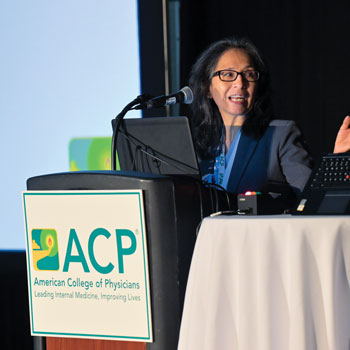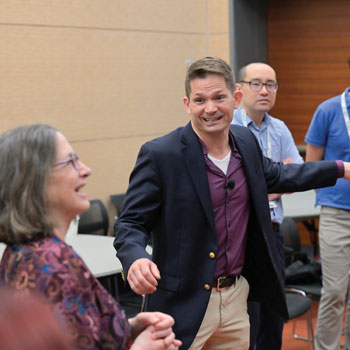Learning to teach in medicine
Speakers at Internal Medicine Meeting 2024 offered practical advice on how to make teaching work in clinical practice.
Academic medicine is the most common place to find teaching positions, but early career physicians who want to get a foot in the door as clinical educators should make sure to consider all their options, according to Allison L. Ruff, MD, FACP.
“Community-based teaching opportunities are amazing,” said Dr. Ruff, who is a clinical associate professor at University of Michigan Health in Ann Arbor. “They … provide an educational environment with one-on-one mentorship outside of the hospital setting. They're more representative of real-world medicine compared to what we see in the hospital clinic. And students in community settings are more likely to have close supervision, see patients and follow up, which we know is important, discuss the case in depth with a preceptor, and rate their experiences highly.”

At a session at Internal Medicine Meeting 2024 titled “Getting Started as a Clinical Educator: How to Incorporate Teaching Into Your Practice,” Dr. Ruff and her copresenter, Katie Jobbins, DO, MS, FACP, offered expert advice and some tips.
Dr. Ruff acknowledged the challenges involved with precepting, including those related to time, finances, and training. Studies show that in traditional outpatient care models, involving students will increase each half-day of clinic by 45 minutes, Dr. Ruff said. She noted that while this effect is neutralized after five months, students don't stay that long in most practice settings.
“The second most cited concern for students in clinic is the financial cost, but I will tell you that the presence of a student is actually not associated with increased hidden costs, such as more labs, prescriptions, or referrals,” Dr. Ruff said.
The third concern is a lack of formal training for those interested in being educators. “People think, ‘Well, you were a learner, so you know how to do the things that they were doing now,’” Dr. Ruff said. She also noted that physicians' limited CME time is usually used to stay up to date on practice changes rather than learning how to teach.
But there's good news, Dr. Ruff said: Studies show that medical faculty who add teaching to their responsibilities often feel less stress. “Community educators, so private practice docs who are out there by themselves, tend to note a decreased sense of professional isolation,” she added. “And physicians who engage as educators in small group settings demonstrate certain markers for reduced burnout, including increased personal and professional growth, increased sense of reward, and a more personal response to medicine.”
Community-based educators can earn clinical appointments as volunteer faculty, and academic physicians can use their clinical teaching position as a credential to be promoted in the clinical pathway. “So many institutions now have clinical pathways, and sometimes that promotion comes with a little pay bump,” Dr. Ruff said.
CME is another potential benefit, she noted: “A lot of people don't know that you can earn two AMA PRA Category 1 CME hours for every hour you're with a student. This learning must [be] affiliated with an LCME [Liaison Committee on Medical Education] institution, so it has to be an accredited med school that you're teaching a student from, but even if you're not at that med school, you're off site, it still counts.”
Next, Dr. Ruff offered some practical advice on how to make teaching work in clinical practice, based on ACP's book “Teaching in Your Office.” First, she recommended selecting patients who are appropriate for novice learners.
“You want to stick with patients who are good historians, who don't have a lot of psychosocial issues, and then increase challenges as they advance,” she said. “Some of your favorite patients, maybe your most socially or medically complex, they might not be the best for a first-day learner.”
Data collection and patient presentation are also important. “Keep in mind, most medical students have a doctoring course where they learn to take a whole history and a full physical exam, and it can take up to 40 minutes or an hour. And that's great, they should learn that,” Dr. Ruff said. “They don't need to be learning that in your clinic.”
When the learner presents the patient's case to the educator, they should be able to know exactly why the patient's there, what the patient thinks is going on, and what they plan to do about it, as well as any evidence that's involved, Dr. Ruff said. To help them accomplish these goals, prime them before you send them in to see the patient.
“You can't just be like, ‘This is the lady, she's here for follow-up, go,’” she said. Earlier in the day, review the most common causes of whatever is bringing each patient in.
“If you feel like that's too kind of prescriptive, you can include the learner in that discussion: ‘What do you think are the most common causes of chest pain?’ If you do that before they go in the room rather than after, then they're not going to spend 30 minutes asking about off-topic things,” Dr. Ruff said.
The final step in organizing the visit involves framing, or setting expectations and time limits. “You need to make it clear to the learner that this is a different kind of setting. This is an outpatient primary care clinic with time constraints and a schedule,” Dr. Ruff said. “It's OK to tell the student, ‘I want you back in this room in X amount of time.’”
Part of teaching, of course, involves providing feedback to learners, and Dr. Jobbins offered advice on getting comfortable with that process.
At the beginning of a rotation, have a conversation with your learners, she advised. Ask them what they're expecting to get out of the experience and what they've been working on, and let them know what you expect.
“We want to be approachable and engaged. Everyone remembers the people we've worked with who've been like, ‘You know what, not now,’” she said. “That really creates this wall.”
It's also important to make sure your learner knows when you're giving them feedback, Dr. Jobbins said. “Unless you say, ‘This is feedback,’ they're going to come back on the rotation [and say] ‘I got nothing from that person,’” she said. “You want to practice. The more you give it, the easier it becomes and allows you to build your credibility.”
Educators may worry about upsetting the learner, but that's unfounded, she stressed.
“If you're giving feedback really well, a learner is not going to get upset because they're using this as growth for themselves as well,” Dr. Jobbins said. “The way to approach this is that you want to dismiss their fears and really make them understand that you're invested in them.”
Feedback also needs to contain criticism so that learners can improve. “Just like you planned your visits and kind of cherry-picked the patients you're going to see, I'm going to think about what type of feedback I want to give them, so that way they can learn the next time they're with me to approach it in a different way,” she said.
Finally, be specific rather than general. “‘You can do better with your physical exam.’ What does that mean?” Dr. Jobbins said. “It's really an opportunity to think about how you can use language. … Give them constructive, actual things that are tangible, that they can grab on to.”
Dr. Jobbins also reviewed three models for time-efficient precepting. The first, the One-Minute Preceptor, includes five microskills. First, get a commitment from the learner about what they think is going on. Second, probe for supporting evidence, that is, the findings that led the learner to this diagnosis. Third, teach them the general rules around this particular presentation, such as ruling out appendicitis when a patient presents with right lower quadrant pain. Fourth, reinforce what the learner has done well, and fifth, correct mistakes. “You can actually layer in the learning while you're going through and discussing the patient,” she said.
The second model, called Aunt Minnie, encourages pattern repetition. “If you see a woman walking across the street who looks like your Aunt Minnie, 90% of time it is your Aunt Minnie,” Dr. Jobbins said. “It's this idea that as you see something over and over again, you start to think that this is likely this diagnosis.”
In the Aunt Minnie model, the learner presents only the main symptom and presumptive diagnosis to the teacher, and then both discuss the case after the teacher has independently seen the patient.
“This allows for students to begin the writeup while you are going in the room to examine the patient, and then you give feedback after you see them to inform additional parts that they may not have considered or they may have missed in their clinical plan,” Dr. Jobbins said. “Then you're able to discuss the management plan for the patient.”
The final model is called SNAPPS, which stands for Summarize the patient case, Narrow the differential, Analyze the differential, Probe the preceptor, Plan management, and Self-directed learning.
“I use this on a regular basis. It's really an active participant teaching model and encourages learning beyond summarizing facts, and it really engages problem solving and critical thinking,” Dr. Jobbins said.
For the first step, the learner obtains the history, performs the physical exam, and presents a summary of their findings to the preceptor. “The summary should be very brief and concise and should be no more than 50% of your whole learning encounter,” Dr. Jobbins said. “I normally say, ‘One to two minutes for you to present this, maybe three at the max.’”
Next, to narrow the differential diagnosis, the learner comes up with two to three possibilities, most to least likely, to revisit later. Analyzing the differential involves determining what supports and refutes each possibility.
Probing the preceptor offers a chance for the learner and educator to discuss areas of confusion. For example, you can talk about what you think the diagnosis is, why you think so, and where the learner might have gaps in their knowledge about why you came to that decision.
“Then you actually want to discuss the pearls,” Dr. Jobbins said. “You are all experts and have amazing education that you can impart onto your learners. They want to be like you.”
Plan management is the time for student and educator to discuss the plan and outline the next steps. “This allows you to really become an expert teacher and an expert teller,” she said. “You're going to sometimes have to tell early learners what the next step is because they don't know it at all, but you can teach them where to find that answer.”
For the last step in this model, self-directed learning, the clinician educator should tell the learner what they should continue to read and learn about, then make a point to ask them about it next time. If you're afraid you won't remember, write it down to make sure you do, just as you would with a patient, Dr. Jobbins advised.
“We all do this. … When you see a patient, you'll write down, ‘going to Aruba.’ Next time you see them, you ask them, ‘How was your trip to Aruba?’ It's the same thing with teaching,” she said. “That's the part where you really can gain that trust and build that rapport with your trainees.”




